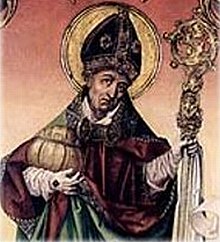Rupert of Salzburg
Rupert of Salzburg | |
|---|---|
 Saint Rupert depicted with a barrel of salt in his hand | |
| Bishop | |
| Born | 660? |
| Died | (710-03-27)27 March 710 Salzburg |
| Venerated in | Roman Catholic Church Eastern Orthodox Church |
| Feast | 24 September [1] 27 March |
| Attributes | Holding a container of salt; wearing clerical clothes including mitre; holding a crosier |
| Patronage | Salzburg, The State of Salzburg, Austria, salt miners |
Rupert of Salzburg (German: Ruprecht,[a]Latin: Robertus, Rupertus; c. 660[b] – 710 AD) was Bishop of Worms as well as the first Bishop of Salzburg and abbot of St. Peter's in Salzburg. He was a contemporary of the Frankish king Childebert III[2] and is venerated as a saint in the Roman Catholic and Eastern Orthodox Churches.[3] Rupert is also patron saint of the Austrian state of Salzburg.
Contents
1 Life
2 Veneration
3 Gallery
4 Notes
5 References
6 Sources
7 External links
Life
Holy tradition states that Rupert was a scion of the Frankish royal Merovingian dynasty;[3] he was possibly related to the Robertians, most likely a descendant of Count palatine Chrodbert II.

Baptism of Duke Theodo by Bishop Rupert, Franciscus de Neve (II) (c. 1670)
As Worms bishop, Rupert was at first accepted as a wise and devout dignitary, however, the mostly pagan community eventually came to reject him and forced him out of the city. By the end of the 7th century, the Agilolfing duke Theodo of Bavaria requested that he come to his residence at Regensburg (Ratisbon) to help spread the Christian faith among the Bavarian tribes.
Rupert then moved to Altötting, where he converted the locals. He sailed down the Danube river, visiting many towns, villages and forts. Soon he had converted a large area along the Danube southeastward to the Bavarian border with the Pannonian lands that then were under the rule of the Avar Khaganate. Here he stayed at Lorch, the former Roman city of Lauriacum (today part of Enns), where an Early Christian church—the present Basilica of St. Lawrence—already existed.
Warlike conditions in the borderlands made him abandon plans of missionary work in the territories of the Pannonian Avars. Instead he proceeded along the Roman road via Seekirchen to the ruined city of Juvavum, where he made his base and renamed the city "Salzburg" (Latin: Salisburgum).[4] Like in Lorch, Rupert was able to build on ancient Early Christian traditions that were already in place. He re-established the convent at St. Peter's Abbey and laid the foundations of Salzburg Cathedral that was finished by his successor Vergilius. He also founded the Benedictine nunnery of Nonnberg beneath the Festungsberg fortifications (later Hohensalzburg Fortress), where his niece Erentrude became the first abbess.
Rupert also introduced education and other reforms. From the hands of Duke Theodo of Bavaria, his bishopric received estates around Piding and Reichenhall, where he promoted the development of the local saltworks. Rupert's mission work also spread into the Alps, where a first monastic cell (Cella Maximiliana) was founded at present-day Bischofshofen about 711.
Rupert reportedly died on Easter Sunday around 710.[5] According to other sources, he returned to his hometown of Worms, where he died in 717. His mortal remains were transferred to Salzburg Cathedral by Bishop Vergilius on 24 September 774.
Veneration
Rupert's life and mission work is documented in medieval chronicles like the Conversio Bagoariorum et Carantanorum. In accordance with Christian tradition, St. Rupert's feast day is celebrated by the Eastern Orthodox Church on the anniversary of his repose, March 27[3] (March 28 according to the Lutheran Calendar of Saints). In Austria, it is September 24,[6] commemorating the translation of his relics to Salzburg Cathedral. Rupertitag is also a public holiday in the State of Salzburg, associated with popular Volksfest events.
Rupert is the patron saint of the State of Salzburg, the Roman Catholic Archdiocese of Salzburg (together with his successor Vergilius), and of the adjacent Bavarian Rupertiwinkel region. He is also known as the "Apostle of the Bavarians" and patron of several settlements like Sankt Ruprecht in Styria or Šentrupert in Slovenia and of numerous church buildings.
Gallery

An Austrian stamp of 1948 depicting a statue of Saint Rupert

Etching of Saint Rupert by Bock after Johann Wolfgang Baumgartner

Head of a Gothic style statue of Saint Rupert

Saint Rupert, as founder of a church ("fundator ecclesiae")
Notes
^ also known as Rudbertus, Roudbertus, Rupertus, Hrodperht, Hrodpreht, and Robert.[2]
^ According to Schmid, "The assumption of 660 as the year of his birth is very likely legendary."
References
^ German language regional calendar, September, Institut für Praktische Theologie
^ ab Ulrich Schmid (1912). "St. Rupert". The Catholic Encyclopedia. 8. Robert Appleton Company. Retrieved 2007-03-27..mw-parser-output cite.citation{font-style:inherit}.mw-parser-output .citation q{quotes:"""""""'""'"}.mw-parser-output .citation .cs1-lock-free a{background:url("//upload.wikimedia.org/wikipedia/commons/thumb/6/65/Lock-green.svg/9px-Lock-green.svg.png")no-repeat;background-position:right .1em center}.mw-parser-output .citation .cs1-lock-limited a,.mw-parser-output .citation .cs1-lock-registration a{background:url("//upload.wikimedia.org/wikipedia/commons/thumb/d/d6/Lock-gray-alt-2.svg/9px-Lock-gray-alt-2.svg.png")no-repeat;background-position:right .1em center}.mw-parser-output .citation .cs1-lock-subscription a{background:url("//upload.wikimedia.org/wikipedia/commons/thumb/a/aa/Lock-red-alt-2.svg/9px-Lock-red-alt-2.svg.png")no-repeat;background-position:right .1em center}.mw-parser-output .cs1-subscription,.mw-parser-output .cs1-registration{color:#555}.mw-parser-output .cs1-subscription span,.mw-parser-output .cs1-registration span{border-bottom:1px dotted;cursor:help}.mw-parser-output .cs1-ws-icon a{background:url("//upload.wikimedia.org/wikipedia/commons/thumb/4/4c/Wikisource-logo.svg/12px-Wikisource-logo.svg.png")no-repeat;background-position:right .1em center}.mw-parser-output code.cs1-code{color:inherit;background:inherit;border:inherit;padding:inherit}.mw-parser-output .cs1-hidden-error{display:none;font-size:100%}.mw-parser-output .cs1-visible-error{font-size:100%}.mw-parser-output .cs1-maint{display:none;color:#33aa33;margin-left:0.3em}.mw-parser-output .cs1-subscription,.mw-parser-output .cs1-registration,.mw-parser-output .cs1-format{font-size:95%}.mw-parser-output .cs1-kern-left,.mw-parser-output .cs1-kern-wl-left{padding-left:0.2em}.mw-parser-output .cs1-kern-right,.mw-parser-output .cs1-kern-wl-right{padding-right:0.2em}
^ abc "Saints of Salzburg", Orthodox England
^ Delehaye 1911.
^ Lives of Sts. Robert (Rupert) and Erendruda, The St. Pachomius Orthodis Library, 1994
^ "Archived copy". Archived from the original on June 27, 2007. Retrieved March 27, 2008.CS1 maint: Archived copy as title (link)
Sources
![]() Delehaye, Hippolyte (1911). . In Chisholm, Hugh. Encyclopædia Britannica (11th ed.). Cambridge University Press.; Endnotes:
Delehaye, Hippolyte (1911). . In Chisholm, Hugh. Encyclopædia Britannica (11th ed.). Cambridge University Press.; Endnotes:
Bibliotheca hagiographica Latina, (Brussels, 1899), n. 7390-7403- W. Levison, “Die älteste Lebensbeschreibung Ruperts von Salzburg” in Neues Archiv für ältere deutsche Geschichtskunde, xxviii. 283 seq.
- Hauck, Kirchengeschichte Deutschlands (3rd ed.), i. 372 seq.
External links
 Media related to Rupert of Salzburg at Wikimedia Commons
Media related to Rupert of Salzburg at Wikimedia Commons- Lives of Sts. Robert (Rupert) and Erendruda



